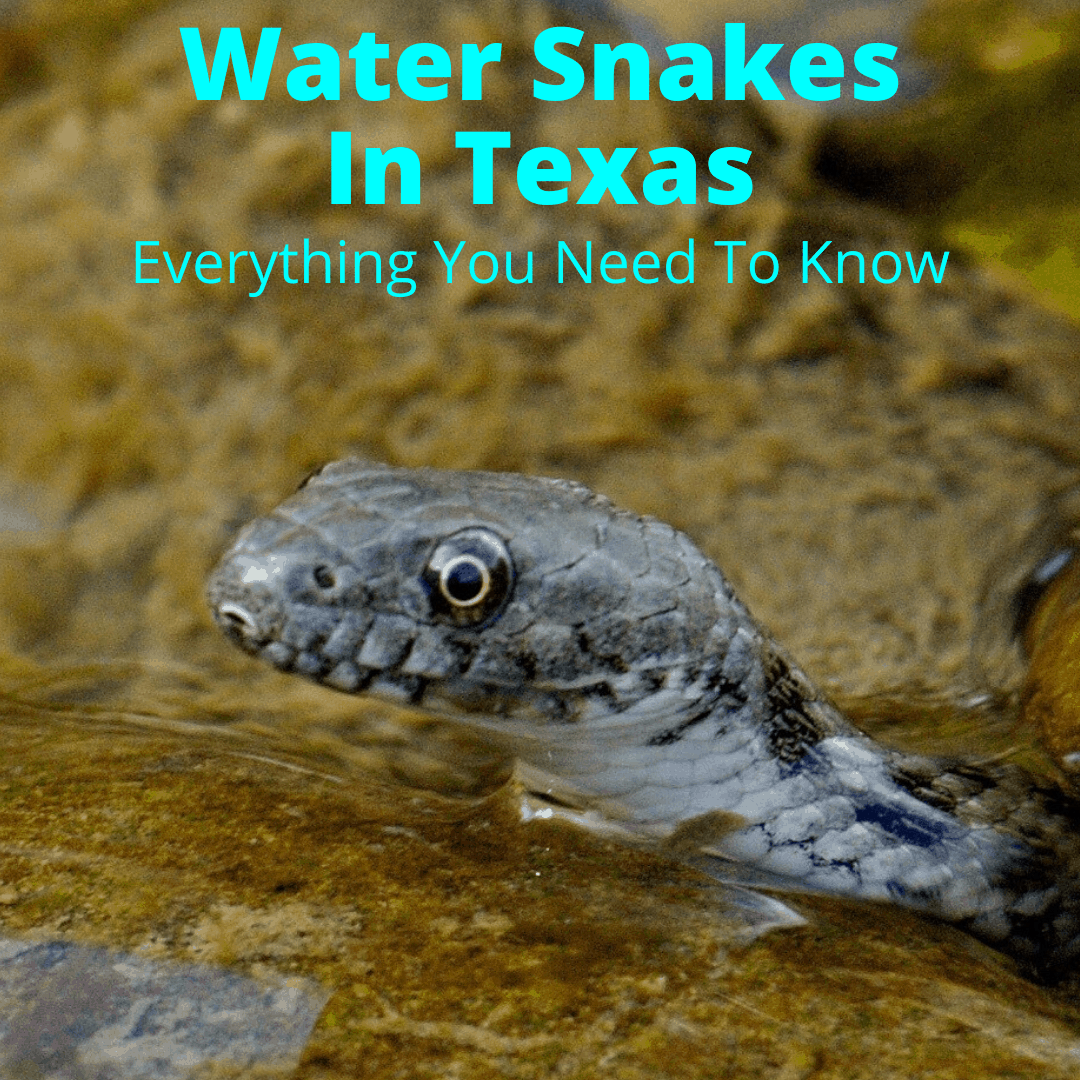
Even if you never see one, just knowing they’re in a lake will keep many people out.
And there are several species of water snakes in Texas.
The good news is: none of them are poisonous.
The bad news is: there is a venomous snake that isn’t a water snake, but still spends a lot of time in the water. And it resembles some of the harmless water snakes.
We’ll learn all about that snake, the non-venomous water snakes, and how you can tell them apart.
Table of Contents
- 1 Water Snakes In Texas
- 2 Water Snakes: General Information
- 3 Texas Water Snakes
- 3.1 The Cottonmouth
- 3.2 Diamond Back Water Snake
- 3.3 Blotched Water Snake
- 3.4 Yellow Bellied Water Snake
- 3.5 Concho Water Snake
- 3.6 Brazos River Water Snake
- 3.7 Red-Bellied Water Snake
- 3.8 Are The Water Snakes Of Texas Endangered?
- 3.9 Is It Legal To Kill Snakes In Texas?
- 3.10 When Are You Most Likely To Encounter Snakes In Texas?
- 4 Water Snakes In Texas: Final Thoughts
Water Snakes In Texas
There are several species of water snakes in Texas. They are non-venomous, but the venomous cottonmouth is semi-aquatic and also found near and in water. It is also known as the water moccasin, but is not an actual water snake.
We will talk more about it and the various species of water snakes below. First, let’s learn a little more about water snakes in general.
Water Snakes: General Information
The last place many people expect to see a snake is when they’re swimming in the sea or in a river. The truth is – all snakes can swim, but there are some snakes that essentially live in the water.
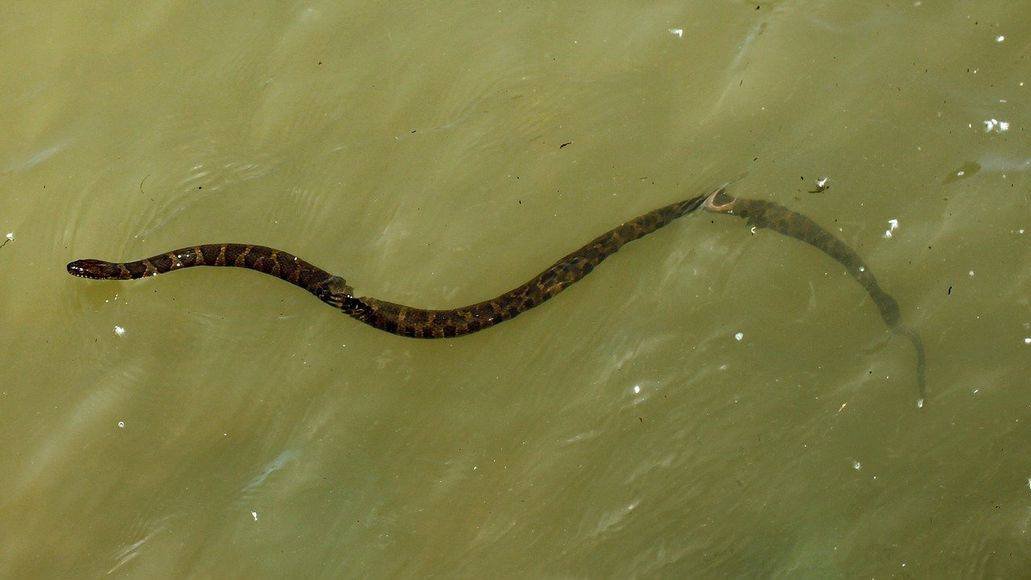
Can snakes swim underwater? Some can. In general, freshwater and sea snakes can swim underwater, while snakes that prefer land do not swim submerged.
Even if they can swim underwater, snakes have to come up for air when swimming. As a result, even snakes that spend their lives in the water stay in shallow waters.
These snakes are known as sea snakes. There are over 40 different species, but all belong to the cobra family. They are highly venomous, but underwater snake bites are rare.
Water snakes are different in that they live inland, but like being close to freshwater and spend a lot of time in it. These snakes belong to the Colubridae family and are mostly drab looking, with brown, gray, or olive green coloration.
These snakes live around or in water, feeding on a rich variety of creatures. They aren’t bound to their watery environments and will leave the water to bask in the sun or to breed.
Some of them even go up into trees where they dangle in the branches above the water. If there is a threat, they simply drop down into the safety of the water.
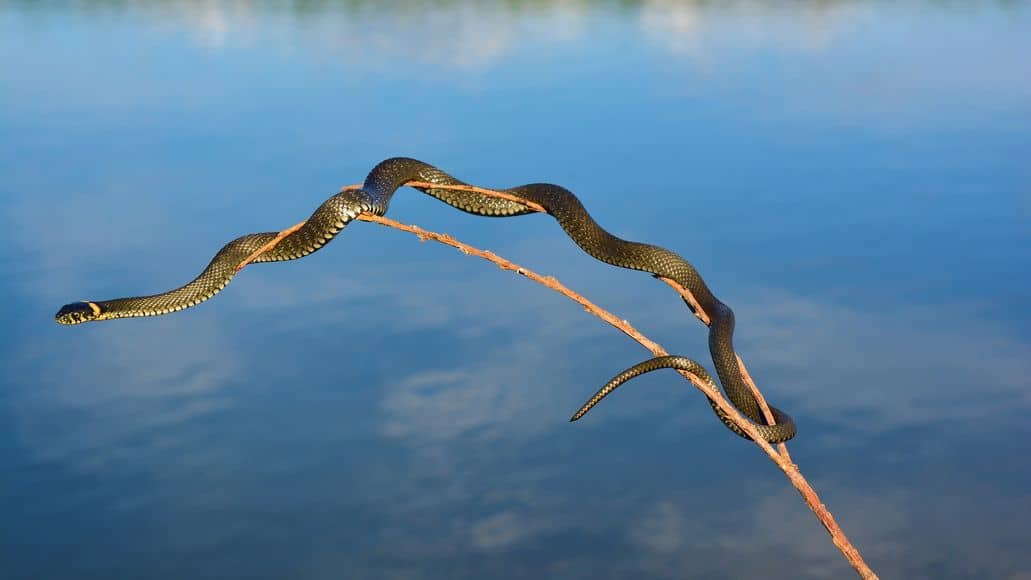
These water snakes are solitary animals and they’re most active during the day, although they are known to hunt at night too. They hibernate in the winter and are fairly social just before and after hibernation, when they are seen basking together in the sun.
Their diets are mainly made up of toads, salamanders, bird eggs and fish. They swallow their prey whole and usually while it is still alive. They normally hunt in shallow water but are prepared to go to deeper waters if need be.
Recent studies tell us that some water snakes produce a venom-like protein in their saliva. This can cause their victim to bleed, so even if it does make an escape, the snake can follow the trail of blood and catch up to it as it slows down from blood loss.
These water snakes are not venomous but they’re aggressive and bad-tempered most of the time. They certainly don’t like being handled and will defecate on you or excrete a foul-smelling substance from their anal scent glands.
In North America, the most abundant water snake is the nerodia, of which there are 11 different species. The tan to grey northern water snake with dark brown blotches is the most common species. It is quite a large snake and gets to about 4.5 feet in length.
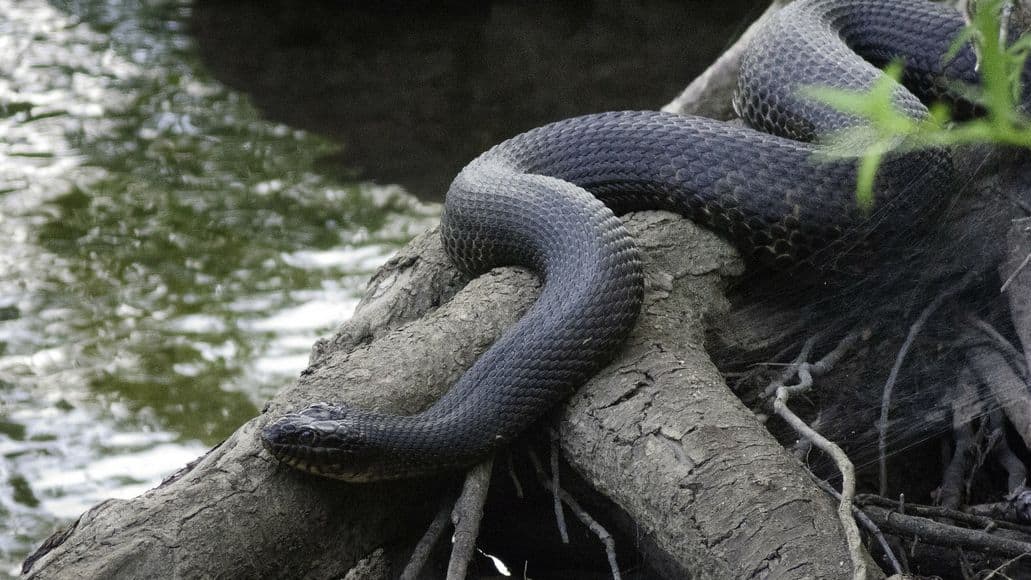
There are many other species of water snakes, each with their own distinctive appearance. The following snakes are found in Texas.
Texas Water Snakes
The following are species of water snakes that live in Texas. The first is not actually a water snake, but it spends much of its time in and near water and is often mistaken for one. This can be dangerous, since it is venomous.
The Cottonmouth
The cottonmouth, also known as the water moccasin, is not a water snake. But it spends much of its time in the water.
It is a venomous semi-aquatic snake with a big triangular head. It can grow to 4 feet in length, making it one of Texas’ biggest snakes. In addition to Texas, it is found all across the southeastern states, like Louisiana, Alabama, Georgia and Florida.
These snakes swim on top of the water, and actually float on the surface of the water when at rest. They are unique in this. Water snakes keep themselves submerged below the water surface.
They have dark cross-bands on a brown and yellow base color with the underside having dark and brownish-yellow blotches. They’re pit vipers and are found in nearly all freshwater habitats, although they spend time on land, too.
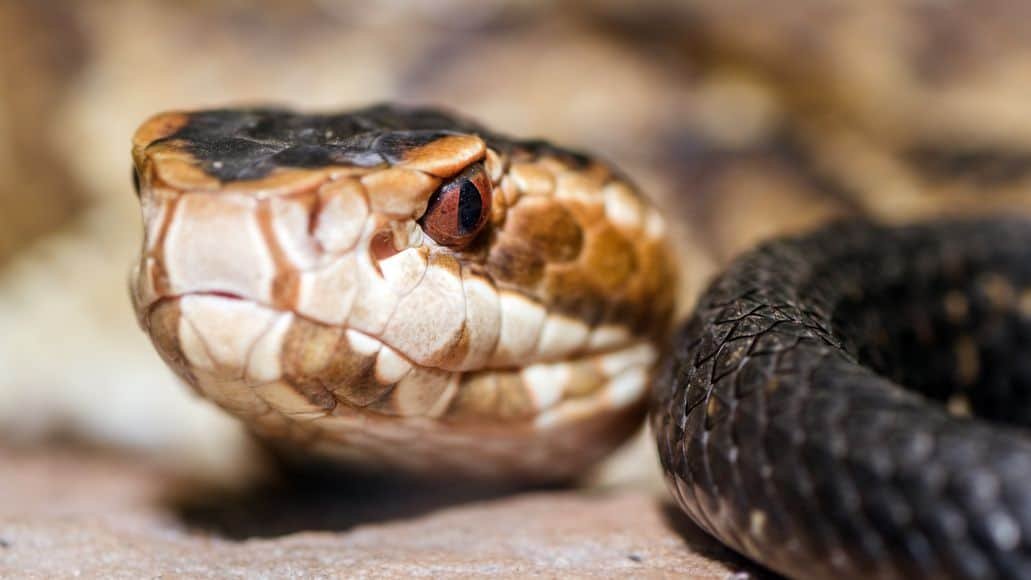
They look for their food after dark, consuming amphibians, lizards, small turtles, and even other snakes. These snakes are ovoviviparous, meaning they give birth to live young.
If you want to identify a water moccasin, you’ll recognize the large, flat, triangular head and the heat-sensing slits around the nose and eye area. Even though these snakes are venomous, they aren’t aggressive like water snakes.
Cottonmouth snakes just want to avoid humans and only attack when threatened. They coil their bodies, vibrate their tails and open their mouths wide as a scare tactic, all the while making a snake hissing sound.
If you do get bit, a water moccasin bite can kill you. But they are rarely fatal, as long as you get prompt medical attention. Nevertheless, it is among the most venomous snakes in Texas.
Water moccasins are fairly short and stocky while water snakes are somewhat longer and more slender. However, there are different kinds of water snakes found in the United States.
And while some look quite different, there are some that even a snake expert would have difficulty with telling apart. It’s because they take on the habits of venomous snakes, pretending to be one in order to ward off threats.
Diamond Back Water Snake
These are the most common water snakes in all of Texas and they live throughout the entire state. The round-eyed diamondback water snake is a non-venomous colubrid snake belonging to the genus nerodia.
You’ll find the snake in different aquatic habitats such as ponds, dams, streams, lakes, and swamps. Occasionally it will wander onto land.
It’s a thick-bodied snake and adults can reach 5 feet in length. The colors are earthy – olive green, grey and dark brown, with dark blotches that run along the back and are connected by a diamond-shaped pattern.
The snake is often mistaken for the venomous cottonmouth snake, but the diamondback water snake, like all water snakes, is irritable and will bite if threatened.
Blotched Water Snake
This snake is olive green to brown with dark grayish-brown blotches across the back. In the middle of each blotch, there is a narrow yellowish cross band. The snake can reach up to 3 feet in length.
The head is flat with dark bars on the lips and this is what separates this snake from the venomous cottonmouth. When this snake is threatened, it flattens its head into a diamond-shaped look which makes many people confuse it with the cottonmouth.
Yellow Bellied Water Snake
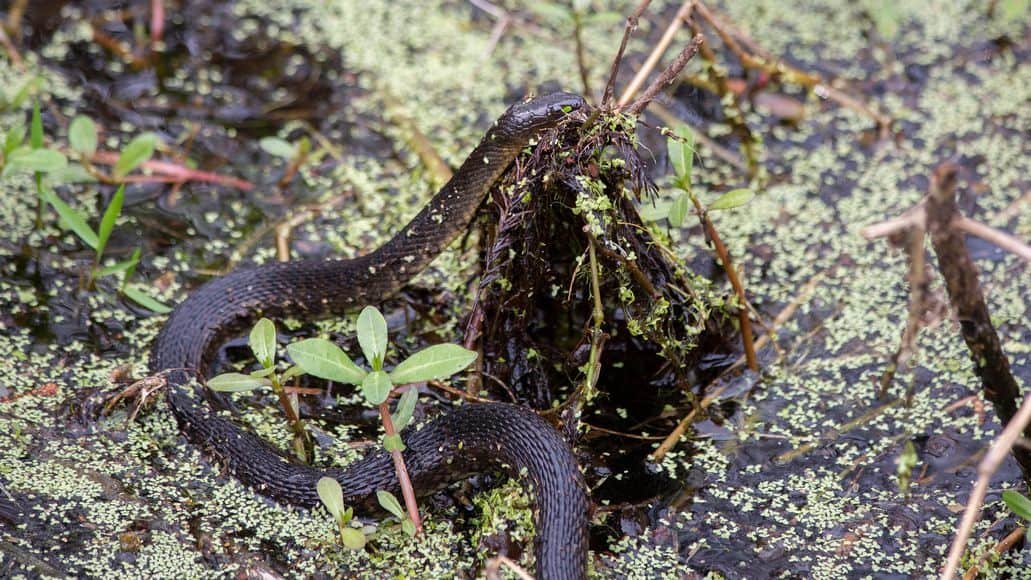
This is a non-venomous, medium sized water snake that you’ll find in ponds, swamps, rivers, and lakes. It has a yellow underside with a greenish/black skin with no pattern. The snake can grow up to about 4 feet.
It lives in the Gulf of Mexico coastal regions, from Georgia to Texas. It is strongly patterned with brown dorsal and lateral blotches that may be joined to form transverse bars.
Concho Water Snake
This is small snake, growing up to 3 feet in length, with dark reddish brown bands on the body. They live in streams in Texas. They hibernate in the winter and become active from March to October. They feed on fish, which they catch by hovering motionless near where they are.
The snakes have to be careful because they can become a meal for the likes of herons, hawks and other snakes. They don’t live particularly long – just 5 years or so.
Brazos River Water Snake
This is a brown-grey snake with rows of spots running along the length of its body. The snake’s pattern is that of a checkerboard.
The Brazos water snake can only be found in North Texas. They’re small snakes and they live along the Brazos River, liking rocky stream beds. It’s a water snake that gives birth to live 12 or so wild young at a time.
Red-Bellied Water Snake
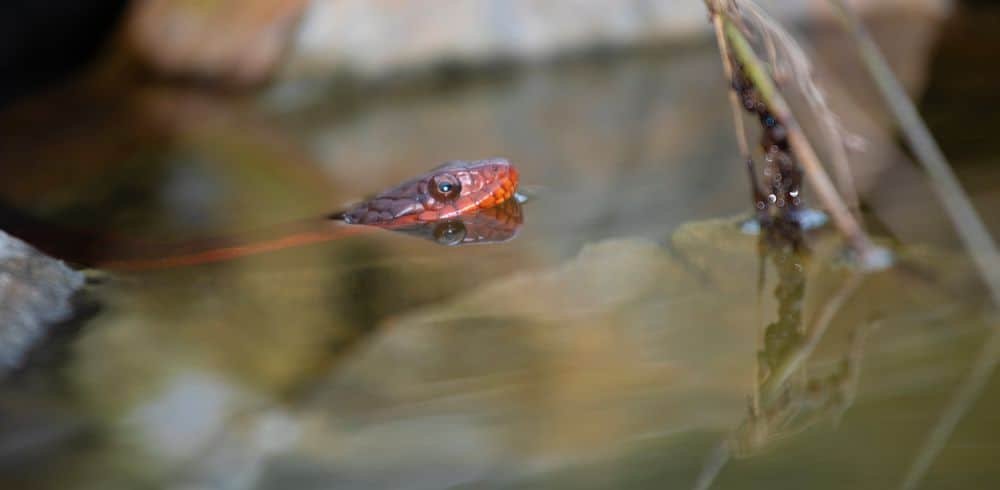
Like the yellow-bellied version we saw above, this is another non-venomous water snake that lives in Texas and other southeastern states. It might not be venomous, but it is much more aggressive than other water snakes and may spray musk or bit when threatened.
The Red-Bellied Water Snake has an unmarked, orange, yellow, or reddish belly, while its back is olive green, chocolate brown, gray, or ebony black. They like to eat fish, toads, frogs, salamanders, newts, and other amphibians.
Are The Water Snakes Of Texas Endangered?
Three of the water snake species have made it onto the IUCN Red List of Threatened Species. Both the concho water snake and the Brazos River water snake.
Is It Legal To Kill Snakes In Texas?
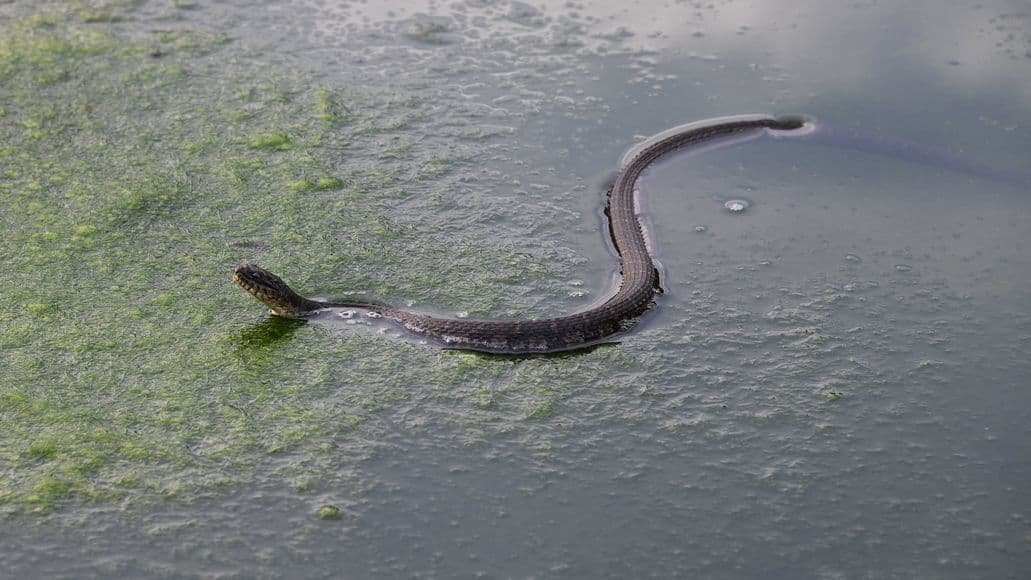
There are many different snakes living in Texas, but only a few of them are venomous. One of them is the cottonmouth, which many people fear and kill as a result. Because other snakes resemble it, people kill those as well.
But the truth is: even venomous snakes play a vital role in our environment – keeping rodent populations in check.
In Texas, there are many snakes that are protected by state law, and indiscriminate killing is illegal. For example, it is illegal to kill a timber rattlesnake in Texas.
If a venomous snakes is bothering you, before using any cruel snake control measures or trying to catch and relocate it on your own, contact representatives of the Texas Parks and Wildlife Department.
Snakes are a natural and important part of the ecosystem and are invaluable for keeping populations of certain pests under control. Snakes are amazing creatures, and you should never kill them. They mean you no harm, so why harm them?
When Are You Most Likely To Encounter Snakes In Texas?
Snake season in Texas runs from March to October. That is when you are most likely to see snakes. They emerge from their hibernation dens in the spring and go back into hibernation (technically brumation) in the fall, when the weather gets colder.
Water Snakes In Texas: Final Thoughts
Even though Texas has several species of water snake, none of them are venomous. But you still need to exercise extreme caution. Some of those harmless water snakes look and act like the venomous cottonmouth snake, which also spends a lot of time in the water.
As always, the best thing you can do before heading out into the wilderness, or just going for a swim in a lake, is to familiarize yourself with the local snake species, especially the venomous ones.
Some snake species can hold their breath for a very long time: up to 2 hours. You won’t see what’s lurking in that swimming hole with you, but it’s good to know what might be. Here is some more information on Texan snakes.
Eleuterio Vasquez says
Hello Gordon,
An aquatic snake recently moved into our backyard pond and I immediately thought: “Kill the water moccasin!” After reading your article and monitoring the snake’s behavior, I can see it’s not deadly. Thank you for sharing your knowledge.
Godspeed,
E Vasquez